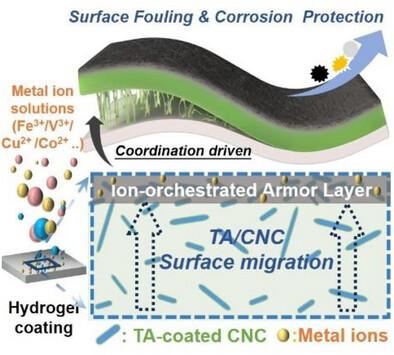仿生离子协调分层铠装水凝胶涂层的坚固和多功能表面保护
IF 19
1区 材料科学
Q1 CHEMISTRY, MULTIDISCIPLINARY
引用次数: 0
摘要
层次化结构的工程水凝胶涂层为多功能表面保护提供了一条很有前途的途径。然而,由于界面力学不匹配,在这种分层结构系统中保持结构完整性仍然是一个关键挑战。这种脆弱的结构最终会损害其表面防污和防腐性能。受海洋海绵有趣的增韧行为的启发,提出了一种离子协调结构工程策略来调节水凝胶涂层的表面微观结构,从而能够直接从水凝胶基质中快速组装表面限制的“装甲层”,而不会影响其整体结构的完整性。分子力测量表明,扩散的金属离子与嵌入的单宁酸工程纤维素纳米晶体(TA/CNC)协调,驱动它们向水凝胶表面定向迁移,并触发原位自组装,形成高模量装甲层(超过700千帕),局部增强了水凝胶涂层的机械坚固性。此外,这种表面受限的亲水护甲层可作为多功能屏障,抑制97%以上的油滴、蛋白质和生物流体的粘附,并通过独特的表面孔隙密封效应,将缓蚀剂浸出率降低84.5%,从而增强表面耐腐蚀性。这些发现为离子驱动的纳米级重组提供了一个新的范例,以定制表面功能,为下一代可持续保护涂层的各种应用铺平了道路。本文章由计算机程序翻译,如有差异,请以英文原文为准。

Biomimetic Ion-Orchestrated Hierarchical Armored Hydrogel Coating for Robust and Multifunctional Surface Protection
Engineering hydrogel coating with hierarchical architecture offers a promising pathway to multifunctional surface protection. However, maintaining structural integrity in such a layered structured system remains a critical challenge due to interfacial mechanical mismatches. Such fragile structures will ultimately compromise their surface antifouling and anticorrosion performance. Inspired by the intriguing skin-toughening behavior of marine sponges, an ion-orchestrated structural engineering strategy is presented to modulate the surface microstructure of hydrogel coatings, enabling the rapid assembly of a surface-confined “armor layer” directly from the hydrogel matrix without compromising its overall structural integrity. Molecular force measurements reveal that diffused metal ions coordinate with embedded tannic acid engineered cellulose nanocrystals (TA/CNC), driving their directional migration toward the hydrogel surface and triggering the in situ self-assembly as a high-modulus armor layer (over 700 kPa) that locally reinforces the mechanical robustness of the hydrogel coating. Moreover, this surface-confined hydrophilic armor layer acts as a multifunctional barrier, suppressing over 97% of oil droplets, protein, and biofluid adhesion, and enhancing surface corrosion resistance by reducing corrosion inhibitor leaching by 84.5% through a unique surface pore-sealing effect. These findings provide a new paradigm for ion-driven nanoscale reorganization to tailor surface functionality, paving the way for next-generation, sustainable protective coatings across diverse applications.
求助全文
通过发布文献求助,成功后即可免费获取论文全文。
去求助
来源期刊

Advanced Functional Materials
工程技术-材料科学:综合
CiteScore
29.50
自引率
4.20%
发文量
2086
审稿时长
2.1 months
期刊介绍:
Firmly established as a top-tier materials science journal, Advanced Functional Materials reports breakthrough research in all aspects of materials science, including nanotechnology, chemistry, physics, and biology every week.
Advanced Functional Materials is known for its rapid and fair peer review, quality content, and high impact, making it the first choice of the international materials science community.
 求助内容:
求助内容: 应助结果提醒方式:
应助结果提醒方式:


